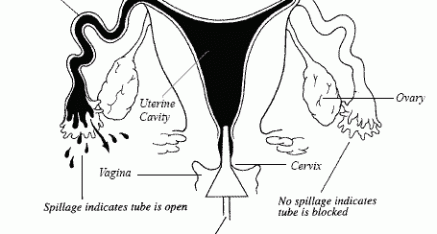Overview
A hysterosalpingogram (HSG) is an X-ray test that looks inside of the uterus and fallopian tubes.

Why It Is Done
A hysterosalpingogram is done to:
- Find a blocked fallopian tube. The test often is done for a woman who is having a hard time becoming pregnant. An infection may cause severe scarring of the fallopian tubes and block the tubes, preventing pregnancy. Occasionally the dye used during a hysterosalpingogram will push through and open a blocked tube.
- Find problems in the uterus, such as an abnormal shape or structure, an injury, polyps, fibroids, adhesions, or a foreign object in the uterus. These types of problems may cause painful menstrual periods or repeated miscarriages.
- See whether surgery to reverse a tubal ligation has been successful.
How To Prepare
Before a hysterosalpingogram, tell your medical provider if you:
- Are or might be pregnant.
- Currently have a pelvic infection (pelvic inflammatory disease) or sexually transmitted disease (such as gonorrhea or chlamydia).
- Are allergic to the iodine dye used or any other substance that has iodine. Also tell your medical provider if you have asthma, are allergic to any medicines, or have had a serious allergic reaction (anaphylaxis) from any substance (such as the venom from a bee sting or from eating shellfish).
- Have any bleeding problems or are taking any blood-thinning medicines, such asapirin or warfarin (such as Coumadin).
- Have a history of kidney problems or diabetes, especially if you take metformin(such as Glucophage) to control your diabetes. The dye used during a hysterosalpingogram can cause kidney damage in people with poor kidney function. If you have a history of kidney problems, blood tests (creatinine, blood urea nitrogen) may be done before the hysterosalpingogram to check that your kidneys are working well.
This test should be done 2 to 5 days after your menstrual period has ended to be sure you are not pregnant.
How It Is Done
A hysterosalpingogram usually is done by a gynecologist and a radiologist in the X-ray room of a hospital. A radiology technologist and a nurse may help the medical provider.
Before the test begins, you may get a sedative or ibuprofen (such as Advil) to help you relax and to relax your uterus so it will not cramp during the test. You will need to undress from the waist down and put on a gown. You will empty your bladder and then lie on your back on an examination table with your feet raised like a pelvic exam.
Sometimes an enema is given a few hours before the test to empty the large intestine.
What To Expect After Surgery
You may want to wear a sanitary napkin after the test because some leakage of the X-ray dye may occur along with slight bleeding.
